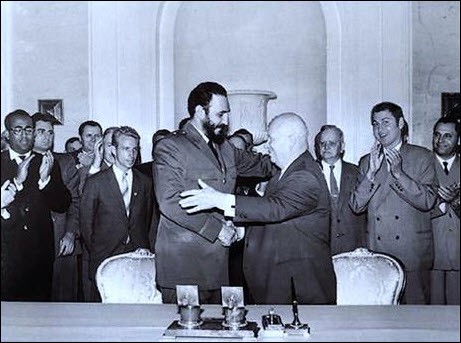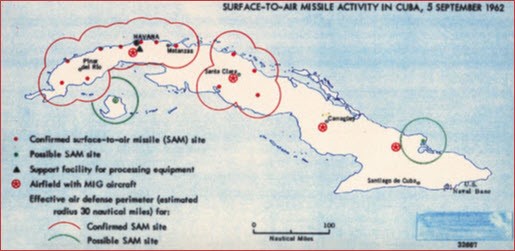THE COLD WAR: PART 2

Stamp Commemorating
Laika, the Soviet Space Dog
Unit
Overview
As
the 1950s progressed, the superpowers continued to battle for supremacy. Although the Cold War was usually fought on
economic and political fronts with little direct confrontation between the
United States and the Soviet Union, it became a hot conflict in Korea in
1950. The death of Joseph Stalin brought
Nikita Khrushchev to power. This Soviet
leader faced off against John Kennedy in the Cuban Missile Crisis, an event
that had the potential to plunge the world into nuclear war. The space race brought on an intense
competition, which ended when the two nations collaborated on the Apollo-Soyuz
Project in 1975. Let’s see how it all
happened.

STOP: Go to Section A Questions
The
Korean War
As
tensions between the superpowers increased in Europe, the Cold War spread to
Asia. Korea, which had been absorbed by Japan
prior to World War II, became a hotspot.
When Japan surrendered in 1945, Korea, like Germany, was divided at the 38th parallel into Soviet and American
zones of occupation. Residents of both
zones claimed the right to unify the peninsula.
By 1948, the Soviet zone had adopted a communist government while the
American zone remained firmly anticommunist.
Fears of a worldwide, communist conspiracy spread. Tension further escalated when China established a communist government
in 1949. This also made Americans even
more determined to pursue the policy of containment
and set the stage for a military response after Soviet-backed, North Korean
forces invaded South Korea in June of 1950.
Following
the attack, the United Nation’s Security Council met immediately without the
Soviet Union, which was boycotting council meetings at the time. The United States called on the U.N. to
demand the withdrawal of North Korean forces and to enforce this measure with
military action, if necessary. Since the
Soviets were not present to exercise their veto power, the resolution passed
the Security Council. Nevertheless,
North Koreans chose to ignore the ultimatum.
The Security Council approved the use of military force in Korea and
received commitments to send troops from sixteen countries. The United States, however, provided the
majority of troops and equipment; U.S. General
Douglas MacArthur was appointed commander of the United Nation’s forces.

The
war proved to be a bitter, bloody conflict.
In the beginning, the North Koreans seized control of most of the Korean
peninsula. The South Korean and U.N.
troops responded by driving their enemies above the 38th parallel. This forced the North Koreans to retreat to
the Chinese border. At this point, China
intervened and pushed the opposition southward.
The war seesawed back and forth until a fragile peace agreement was
reached in 1953. The 38th parallel
remained the dividing line between the two Korean states. North Korea continued as a communist nation,
but the United States achieved its goal of containing communism above the 38th
parallel. South Korea maintained its
democratic government, and the superpowers avoided a direct confrontation with
no risk of nuclear combat.
STOP: Go to Section B Questions.
De-Stalinization
Although
the Soviet Union emerged from World
War II as a superpower, the Russian people continued to experience a low
standard of living. Shortages of food,
fuel and necessary consumer goods were common.
Many were victimized by Joseph Stalin’s ruthless policies that were
enforced by secret police, purges and sentences served in labor camps. Following the death of Stalin in 1953, Nikita Khrushchev emerged as the new Soviet leader. Although he did not advocate a change in his
country’s goals, Khrushchev did pursue what he called de-Stalinization and criticized the former leader’s abuse of
power. In spite of objections from
Stalin’s supporters, he pushed to ease the tension brought about by the Cold
War and suggested peaceful co-existence with the West.
This
did not, however, include a more permissive attitude toward Eastern
Europe. Khrushchev sent tanks and other
heavy military equipment to put down a revolt in Hungary in 1956 and dealt harshly with his critics within the
Soviet Union. The Hungarians hoped that
the United States would come to their aid.
Since this did not happen, they had little choice but to continue their
subservience to the Soviets. The deaths
of the revolt’s leaders and the imprisonment of over 22,000 participants
underscored this point. By 1960,
Khrushchev’s favorable comments regarding peace were often mixed with hostile
statements toward the United States and Western Europe.

Fidel
Castro (left) and Nikita Khrushchev (right):
1961
STOP: Go
to Section C Questions.
The Cuban Missile Crisis
Direct
confrontations between the superpowers seldom occurred during the Cold War, but
the Cuban Missile Crisis was a
notable exception. In the 1950s, Cuban
society mostly consisted of a relatively few, very rich individuals and a large
number of very poor individuals. For
some young Cubans, socialism seemed a better alternative than the corruption
and oppression offered by the country’s dictator, Fulgencio Battista. Their
first attempt to overthrow Cuba’s government failed, but several of the rebels
managed to flee to Sierra Maestra, a remote, mountainous region of Cuba. Here, they educated themselves and studied
the tactics used by other revolutionaries.
They gained the support of many poverty-stricken Cuban peasants. Under the leadership of Fidel Castro, the
rebels overthrew the government and took charge. To strengthen his position, Castro tried
those who were accused of abusing the poor and executed them. He also nationalized all American companies
doing business on the island and used the money for reforms, such as the
creation of a national healthcare system.
In
the meantime, some Cubans fled to the America and claimed that, in reality,
Castro was no better than Battista. The
United States responded by declaring a trade embargo against Cuba and refused to buy Cuba’s most lucrative
export, sugar. Fidel Castro’s philosophy
shifted from socialism to communism when Soviet leader Nikita Khrushchev
offered to buy Cuban sugar. This
resulted in a Soviet ally and pro-communist nation only ninety miles from the
state of Florida. President John Kennedy, consistent with the U.S.
policy of containment, agreed to support a group of anticommunist Cuban exiles,
who landed on the island near the Bay of
Pigs in 1961. Castro’s military
annihilated the rebels and quickly ended their attempt to remove the communist
dictator from power. The incident not
only provoked the further deterioration of U.S.-Soviet relations, but it also
encouraged the suspicion of sabotage between the superpowers.

U.S. Intercepting a Russian Carrier
during the Cuban Missile Crisis
In
1962, photographs taken during the flight of a U-2 spy plane over Cuba revealed
the construction of a base for intermediate-range missiles with nuclear
capability. American intelligence
revealed that Soviet ships were heading toward Cuba with more shipments of
missiles. In total, the Soviets sent
forty-two medium-range missiles and twenty-four intermediate ones along with
22,000 military personnel. For
Khrushchev, this seemed a logical response to U.S. missiles close to the Soviet
border in Turkey and an attempt to
overthrow a communist government. The
United States sent two letters of protest to the Soviet Union and placed a type
of naval blockade known as a quarantine
in the path of the Soviet military cargo ships.
News organizations broadcast reports of the crisis around the world, and
the fear of a nuclear war reached global proportions. Rather than risk a direct military
engagement, the Soviet ships altered course and returned to the Soviet
Union.

Map Showing the Placement of Soviet Missiles
in Cuba: 1962
The
Soviets agreed to remove all of their missiles from Cuba, an action that was
completed within two months. The United
States ended its naval quarantine and promised never to invade Cuba again. The U.S. missiles sites located in Turkey
were also dismantled. Another outcome of
the Cuban situation was the installation of a direct telephone line between
Moscow and Washington D.C. to ease communication between the superpowers in
times of crisis. The final result was
viewed as a success for the Kennedy administration, but it contributed to the
political downfall of Nikita Khrushchev in 1964.
STOP: Go to Section D Questions.
The Space
Race
In
October of 1957, Soviet technicians launched Sputnik, the first satellite, into the earth’s orbit. About the size of a beach ball, this shiny,
metal orb, trailed by four antennas, quickly followed the successful Soviet
test of a hydrogen bomb and made headlines around the world. Americans concluded that, if the Soviets had
rockets powerful enough to put a satellite into orbit, they also had rocketry
capable of striking the continental U.S. with nuclear warheads. This was enough to convince the American
public to support the allocation of millions of tax dollars to overtake the
Russians in the space race. The Soviet
Union was equally dedicated to maintaining its lead and also spent vast amounts
of money on its space program.

Cosmonaut
Yuri Gagarin
For
the next two decades, the superpowers engaged in a number of technological and
engineering firsts. In the fall of 1957,
the Soviet Union launched Sputnik II and sent Laika, a Russian dog, on a quick space flight. The United States followed with its first
successful satellite venture, Explorer I,
in early 1958. President Eisenhower
authorized the creation of the National
Aeronautics and Space Administration (NASA), and the agency soon sent up
the world’s first communications satellite. In 1961, Soviet cosmonaut Yuri Gagarin became the first man in space when Vostok I carried him on an orbit around
the earth. Later that same year, the
United States responded by sending Alan
Shepard on the first American manned space flight and with the Friendship VII mission, which completed
three orbits with astronaut John Glen
aboard in February of 1962. President
John Kennedy, determined to put the United States in the forefront of the space
race, announced the intent of putting a man on the moon by the end of the
decade, and this became a reality in 1969.
The space race drew to a close in 1975 with the Apollo-Soyuz Project, a collaborative effort shared by the
superpowers and the first of many combined aeronautic ventures. Although it sometimes increased Cold War
anxiety, space exploration and its accompanying technology has produced global
benefits in the areas of telecommunications and computer science.
STOP: Go to Section E Questions.
What
Does It All Mean?
The
Cold War rivalry and the fight for international superiority was fueled by the
events of the 1950s and 1960s. Military
operations in Korea, an intense confrontation over Cuba and an expensive but
productive space race all served to intensify the distrust between the United
States and the Soviet Union. Both sides,
however, remained wary of being the first to deploy nuclear weapons. The United States continued to operate based
on the policy of containment, and the Soviet Union maintained its determination
to achieve security. By the 1970s,
however, the Cold War would draw the United States into Vietnam and the Soviets
into Afghanistan. These long, costly
conflicts would prove difficult to win by traditional military tactics.
Additional Resources and Activities
The Start of the Space Race (article with quiz)